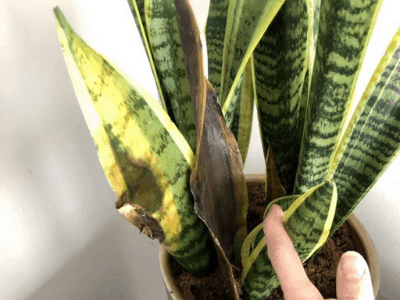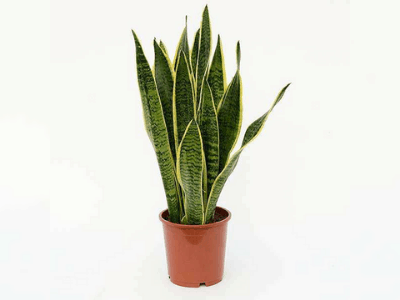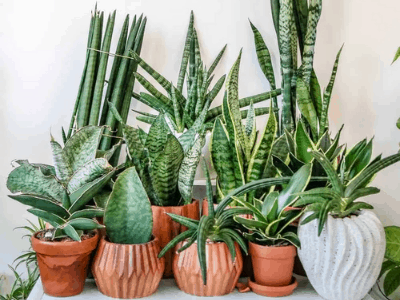
Sansevieria or (san-se-vi-ah) in the Lily family, also known as one of the world’s most popular plants.
On the basis of molecular phylogenetic studies, Sansevieria has been included in the genus Dracaena…
…which is native to tropical Africa in particular, Madagascar, and southern Asia.
The 70 or so species formerly placed in the genus have been known by many common names…
…including mother-in-law’s tongue, devil’s tongue, jinn’s tongue, bow string hemp, snake plant, and snake tongue.
According to the APG III classification system, Dracaena is a member of the family Asparagaceae…
…subfamily Nolinoideae (formerly the family Ruscaceae). It has also been placed in the family Dracaenaceae.
With its durability, the Sansevieria makes an excellent choice for apartment dwellers who typically have difficulty…
….with houseplants due to limited lighting. They should take a good look at snake plants.
As the most tolerant of all decorative plants, Sansevieria can survive the harshest growing conditions, abuse and neglect.
Simply put, sansevieria is a tough houseplant to kill. Snake plants are versatile, classic houseplants with sword-like foliage.
The great thing about this plant is that it’s a great plant for forgetful gardeners and it’s an excellent air purifier plant for indoor environments.
Despite being a resilient succulent that can grow from 6 inches to several feet, snake plants have a number of health benefits.
Household plants are often strategically placed for decoration and to maintain good feng shui.
But did you know that some of these same plants also have some health benefits?
You might be surprised to learn that snake plants bring both health benefits and beauty to your home.
Keep reading to discover the snake plant’s benefits, how to care for one, and how to keep it alive.
Before that here we have story from Kenny about his experience having and caring snake plant as his first houseplant.
Let us hear Kenny’s story…
I’ve always wanted to own a plant, but never had the opportunity.
A few days ago I stumbled across a snake plant that was on sale for $4.00 at our local grocery store!
It looked like it would be easy to care for and with all the research I could do online, it seemed perfect!
Plus there were some great coupons in the flyer so I really got lucky too.
The first day we brought it home, we put in potting soil and water it thoroughly.
After that we set up an area of sunlight where its light could reach because this way it will grow faster…
...than if they are in other spaces in our house or outside somewhere.
We also checked out how much sun light each side so it can grow healthy.
After 2 months this plant having a good growing and beyond my expectation

If a prize were available for the most tolerant plant, snake plant (Sansevieria) would certainly be one of the frontrunners. Snake plant care is very straightforward. These plants can be neglected for weeks at a time; yet, with their strappy leaves and architectural shape, they still look fresh.
GardeningKnowHow, author from gardeningknowhow.com
Here’s the main thing…
Basic Snake Plant Care
Snake plant tends to have an indifferent relationship with lighting and humidity but can be extremely fussy..
…about the amount of water it receives. Mother-in-law tongues typically thrive best in small pots with tightly crowded rhizomes.
The plants do not require fertilization, but if you feel like doing something nice for the plant…
….use a half strength houseplant food once a month during the growing season.
These valuable plants enhance the home with tropical beauty, and clean the air.
Spread the love by growing poisonous snake plants at home and give your friends and neighbors a special gift.

Go on…
Why Choose This Plant? Is It Worth It?
Well, this plant is one of the famous houseplant that you will ever had. Recognizable and easy to care!
Isn’t that great? The snake plant is native to Africa’s tropical western region, from Nigeria to Congo…
…where she goes by the scientific name Sansevieria trifasciata; however, she goes by a variety of other names.
She is most recognized as “snake plant,” or “mother-in-law’s tongue” because of the shape and the sharpness of her leaves.
In Brazil, they call her “Espada de São Jorge,” because she is associated with the sword of Saint George, and in Japan…
… they call her “Tiger’s tail”. Like all famous people, the snake plant suffered criticism.
She was associated with bad luck. This is just a rumor. In fact, the plant was cherished in ancient times…
..and was believed to bring good luck in several countries.
In China, people who possessed this plant were subject to receiving eight virtue gifts from the Eight Gods…
..which includes Prosperity, Beauty, Long Life, Intelligence, Health, Art, Strength, and Poetry.
This plant will attract positive energy and good luck to your home, giving you a feeling of well-being and a feeling of security.

The Challenge Having This Plant
If you’re looking for a new challenge for your green fingers, there are several hardy and easy to care for plants that could be chosen.
The snake plant, or Sansevieria, may fit your criteria and be one that you haven’t come across before.
A snake plant is very common on many gardeners’ “scary plant list” and we’ll answer…
…one of the most common questions about the plant, which is how fast does it grow?

Next up…
Snake Plant Growth Rate
Snake plant grows slowly when under moderate lighting conditions, in indoor or outdoor conditions.
However, if exposed to long periods of sunlight hours, it sprouts quite rapidly.
Other conditions, such as the variety of Sansevieria you have planted, will greatly influence its final size.
Sanseviera trifaciata laurentii is the most commonly grown variety of Sansevieria…
….and has earned the humorous nickname Mother-in-Law’s tongue because of its long…
….pointed leaves that extend from the roots and soil.
How Large Do They Grow?
A snake plant, S. trifaciata laurentii, is the most easily recognizable among snake plants.
Its leaves are variegated, which means they have irregular stripes of snakeskin yellow and green on one side.
It is made up of deeply divided leaves that grow straight upward and produces groups of white flowers…
…and a strong fragrance when they flower. Sansevierias in this particular variety grow to between 1-2 feet…
…and some hybrids even exceed 3 feet, depending on sunlight and other growing conditions.
The Snake Plant trifaciata is also a popular variety. This variety is similar to the S. trifaciata laurentii…
…but lacks the laurentii part. Differentiating characteristics are the lack of yellow stripes along the sides…
…of the leaves, and a proportionally shorter height.
Sansevieria cylindrica, also known as the Spear Sansevieria, is one variety with a remarkably different texture and color.
The leaves on the S. cylindrica are cylinder-shaped and very rigid once they have matured.
As such, these guys are difficult to bend without breaking. Their leaves usually grow in a fan-like manner.
In their freshest, most flexible state, leaves are very easy to weave.
Nurseries and garden centers can take advantage of this and weave them together to create a plait.
This gives the plant a similar style to the “money tree” plant.
Different growth rates of snake plants is on display when comparing the S. trifaciata/S. trifaciata laurentii and the S. cylindrica.
The S. trifaciata/S. trifaciata laurentii can occasionally grow as tall as 3 foot where as the S. cylindrica…
….can grow to a height of over 7 feet At the opposite end of the scale is the variety S. trifaciata “hanhii.”
Growing to only a few inches tall, this species is almost identical to S. trifaciata laurentii with green interiors…
…and yellow stripes surrounding them.
The S. trifaciata variety is a dwarf variety, which makes it an excellent plant for terrariums.
Last but not least…
How to Slow Undesirable Growth
In the event you notice outward growth, there is a very simple way to deal with it.
Simple split or divide the snake plant, and trim away any unwanted foliage.
Alternatively, the sections can be divided and re-planted into separate pots if you’re planning on growing multiple plants.
Snake plants require less time to re-grow when divided since their root system is rhizome based.
The Rhizome root system consists of horizontal roots that result in new shoots and leaves growing from the soil…
…while at the same time maintaining their position horizontally.
The separate pieces of the Rhizome are spliced together to form separate plants.
When growth is upward rather than inward, you can cut the leaf at your desired height.
As we mentioned previously, the leaf won’t continue to grow.
By curbing both upward and outward growth, you can potentially force your Sansevieria into blooming.
Without being able to grow in either direction, the snake plant will often try to propagate all over the place.
Although this is not necessarily a bad thing because the Sansevierias do not bloom often, this can be used…
…as a way to encourage blooming and is only mildly stressful to the plant.
However, after blooming, the plant will probably stop growing new leaves.
It boasts a unique set of characteristics and allows gardeners to choose a vibrant and healthy plant…
…though it may be quite hardy. Following these guidelines will ensure the health and protection of your snake plant.
Sum Up
See having Snake plant is good choice for you to have! It’s cool, its famous, it’s easy to have and care!
What else do you need? In this pandemic time like this, is a good choice for you to have an new activity…
…and having snake plant is a good choice for you to have!
Conclusion
Last thing for sure. This plant need to be care carefully, remember plant need the “love” too.
Alright that’s all for today! Do you have any questions about all of this?
Or do you want to add some good method for caring and having snake plant?
Let me know your recommendation from the comment below.
I hope you can now take care your snake carefully and grow it big!
Thanks for reading this article! Bye!

